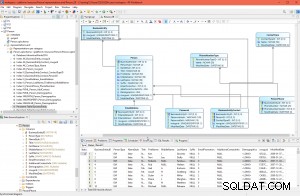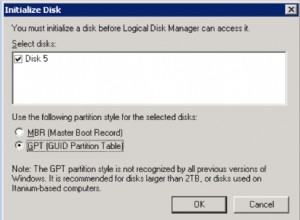Wiem, że to stary wątek, ale był bardzo przydatny. Mam dokładnie taką samą sytuację jak Cade Roux, ponieważ chciałem mieć funkcjonalność w stylu /netonly.
Odpowiedź Johna Rascha działa z jedną małą modyfikacją!!!
Dodaj następującą stałą (wokół wiersza 102 dla spójności):
private const int LOGON32_LOGON_NEW_CREDENTIALS = 9;
Następnie zmień wywołanie na LogonUser aby użyć LOGON32_LOGON_NEW_CREDENTIALS zamiast LOGON32_LOGON_INTERACTIVE .
To jedyne zmiana, którą musiałem wprowadzić, aby to działało idealnie!!! Dziękuję John i Cade!!!
Oto zmodyfikowany kod w całości ułatwiający kopiowanie/wklejanie:
namespace Tools
{
#region Using directives.
// ----------------------------------------------------------------------
using System;
using System.Security.Principal;
using System.Runtime.InteropServices;
using System.ComponentModel;
// ----------------------------------------------------------------------
#endregion
/////////////////////////////////////////////////////////////////////////
/// <summary>
/// Impersonation of a user. Allows to execute code under another
/// user context.
/// Please note that the account that instantiates the Impersonator class
/// needs to have the 'Act as part of operating system' privilege set.
/// </summary>
/// <remarks>
/// This class is based on the information in the Microsoft knowledge base
/// article http://support.microsoft.com/default.aspx?scid=kb;en-us;Q306158
///
/// Encapsulate an instance into a using-directive like e.g.:
///
/// ...
/// using ( new Impersonator( "myUsername", "myDomainname", "myPassword" ) )
/// {
/// ...
/// [code that executes under the new context]
/// ...
/// }
/// ...
///
/// Please contact the author Uwe Keim (mailto:[email protected])
/// for questions regarding this class.
/// </remarks>
public class Impersonator :
IDisposable
{
#region Public methods.
// ------------------------------------------------------------------
/// <summary>
/// Constructor. Starts the impersonation with the given credentials.
/// Please note that the account that instantiates the Impersonator class
/// needs to have the 'Act as part of operating system' privilege set.
/// </summary>
/// <param name="userName">The name of the user to act as.</param>
/// <param name="domainName">The domain name of the user to act as.</param>
/// <param name="password">The password of the user to act as.</param>
public Impersonator(
string userName,
string domainName,
string password)
{
ImpersonateValidUser(userName, domainName, password);
}
// ------------------------------------------------------------------
#endregion
#region IDisposable member.
// ------------------------------------------------------------------
public void Dispose()
{
UndoImpersonation();
}
// ------------------------------------------------------------------
#endregion
#region P/Invoke.
// ------------------------------------------------------------------
[DllImport("advapi32.dll", SetLastError = true)]
private static extern int LogonUser(
string lpszUserName,
string lpszDomain,
string lpszPassword,
int dwLogonType,
int dwLogonProvider,
ref IntPtr phToken);
[DllImport("advapi32.dll", CharSet = CharSet.Auto, SetLastError = true)]
private static extern int DuplicateToken(
IntPtr hToken,
int impersonationLevel,
ref IntPtr hNewToken);
[DllImport("advapi32.dll", CharSet = CharSet.Auto, SetLastError = true)]
private static extern bool RevertToSelf();
[DllImport("kernel32.dll", CharSet = CharSet.Auto)]
private static extern bool CloseHandle(
IntPtr handle);
private const int LOGON32_LOGON_INTERACTIVE = 2;
private const int LOGON32_LOGON_NEW_CREDENTIALS = 9;
private const int LOGON32_PROVIDER_DEFAULT = 0;
// ------------------------------------------------------------------
#endregion
#region Private member.
// ------------------------------------------------------------------
/// <summary>
/// Does the actual impersonation.
/// </summary>
/// <param name="userName">The name of the user to act as.</param>
/// <param name="domainName">The domain name of the user to act as.</param>
/// <param name="password">The password of the user to act as.</param>
private void ImpersonateValidUser(
string userName,
string domain,
string password)
{
WindowsIdentity tempWindowsIdentity = null;
IntPtr token = IntPtr.Zero;
IntPtr tokenDuplicate = IntPtr.Zero;
try
{
if (RevertToSelf())
{
if (LogonUser(
userName,
domain,
password,
LOGON32_LOGON_NEW_CREDENTIALS,
LOGON32_PROVIDER_DEFAULT,
ref token) != 0)
{
if (DuplicateToken(token, 2, ref tokenDuplicate) != 0)
{
tempWindowsIdentity = new WindowsIdentity(tokenDuplicate);
impersonationContext = tempWindowsIdentity.Impersonate();
}
else
{
throw new Win32Exception(Marshal.GetLastWin32Error());
}
}
else
{
throw new Win32Exception(Marshal.GetLastWin32Error());
}
}
else
{
throw new Win32Exception(Marshal.GetLastWin32Error());
}
}
finally
{
if (token != IntPtr.Zero)
{
CloseHandle(token);
}
if (tokenDuplicate != IntPtr.Zero)
{
CloseHandle(tokenDuplicate);
}
}
}
/// <summary>
/// Reverts the impersonation.
/// </summary>
private void UndoImpersonation()
{
if (impersonationContext != null)
{
impersonationContext.Undo();
}
}
private WindowsImpersonationContext impersonationContext = null;
// ------------------------------------------------------------------
#endregion
}
/////////////////////////////////////////////////////////////////////////
}




